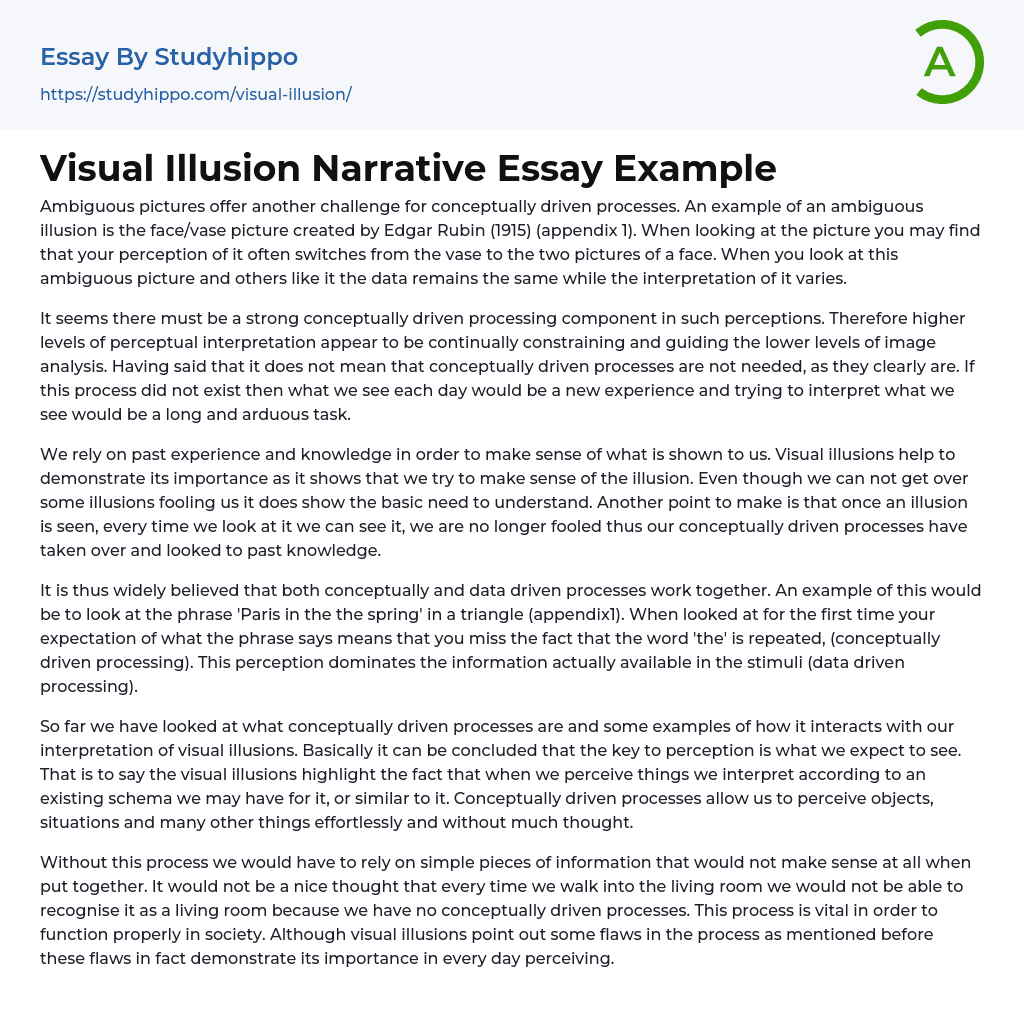Ambiguous pictures offer another challenge for conceptually driven processes. An example of an ambiguous illusion is the face/vase picture created by Edgar Rubin (1915) (appendix 1). When looking at the picture you may find that your perception of it often switches from the vase to the two pictures of a face. When you look at this ambiguous picture and others like it the data remains the same while the interpretation of it varies.
It seems there must be a strong conceptually driven processing component in such perceptions. Therefore higher levels of perceptual interpretation appear to be continually constraining and guiding the lower levels of image analysis. Having said that it does not mean that conceptually driven processes are not needed, as they clearly are. If this process did
...not exist then what we see each day would be a new experience and trying to interpret what we see would be a long and arduous task.
We rely on past experience and knowledge in order to make sense of what is shown to us. Visual illusions help to demonstrate its importance as it shows that we try to make sense of the illusion. Even though we can not get over some illusions fooling us it does show the basic need to understand. Another point to make is that once an illusion is seen, every time we look at it we can see it, we are no longer fooled thus our conceptually driven processes have taken over and looked to past knowledge.
It is thus widely believed that both conceptually and data driven processes work together. An example of this would be to look at the phrase 'Paris in the
the spring' in a triangle (appendix1). When looked at for the first time your expectation of what the phrase says means that you miss the fact that the word 'the' is repeated, (conceptually driven processing). This perception dominates the information actually available in the stimuli (data driven processing).
So far we have looked at what conceptually driven processes are and some examples of how it interacts with our interpretation of visual illusions. Basically it can be concluded that the key to perception is what we expect to see. That is to say the visual illusions highlight the fact that when we perceive things we interpret according to an existing schema we may have for it, or similar to it. Conceptually driven processes allow us to perceive objects, situations and many other things effortlessly and without much thought.
Without this process we would have to rely on simple pieces of information that would not make sense at all when put together. It would not be a nice thought that every time we walk into the living room we would not be able to recognise it as a living room because we have no conceptually driven processes. This process is vital in order to function properly in society. Although visual illusions point out some flaws in the process as mentioned before these flaws in fact demonstrate its importance in every day perceiving.
- Age Of Enlightenment essays
- Ethos essays
- Time essays
- Acceptance essays
- Meaning Of Life essays
- Reality essays
- Natural Law essays
- Political Philosophy essays
- Utilitarianism essays
- Existence essays
- Free Will essays
- Good And Evil essays
- Confucianism essays
- Relativism essays
- Conscience essays
- Environmentalism essays
- Empiricism essays
- Epistemology essays
- Ethics essays
- Existentialism essays
- Human Nature essays
- Individualism essays
- Metaphysics essays
- Philosophy Of Life essays
- Transcendentalism essays
- Truth essays
- Destiny essays
- Determinism essays
- Fate essays
- Functionalism essays
- Philosophers essays
- Pragmatism essays
- Future essays
- Child Observation essays
- Critical Reflection essays
- Teaching Philosophy essays
- Personal Philosophy essays
- Action Speak Louder Than Words essays
- Can Money Buy Happiness essays
- Values of Life essays
- Ethical dilemma essays
- Normative Ethics essays
- Virtue Ethics essays
- Belief essays
- Deontology essays
- Moral essays
- Virtue essays
- Work Ethic essays
- Henry David Thoreau essays
- Carl Jung essays




